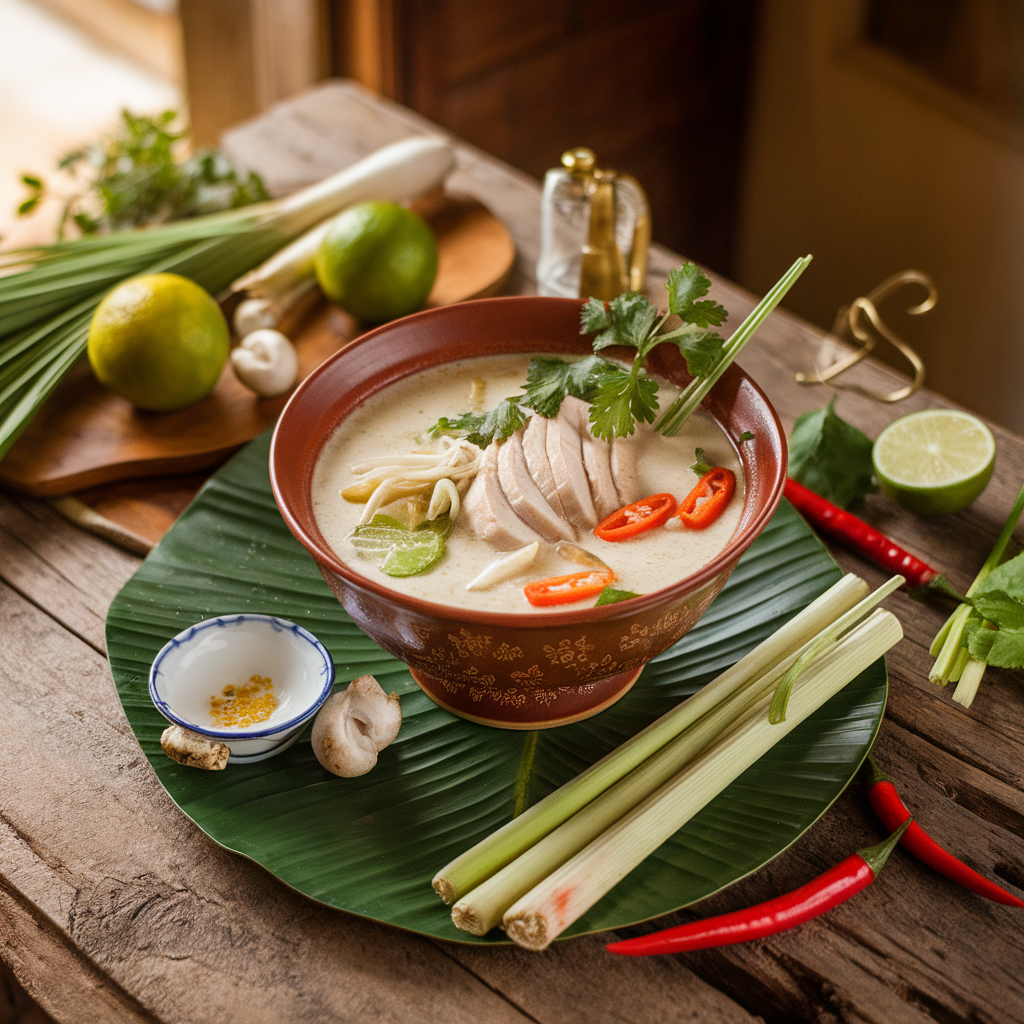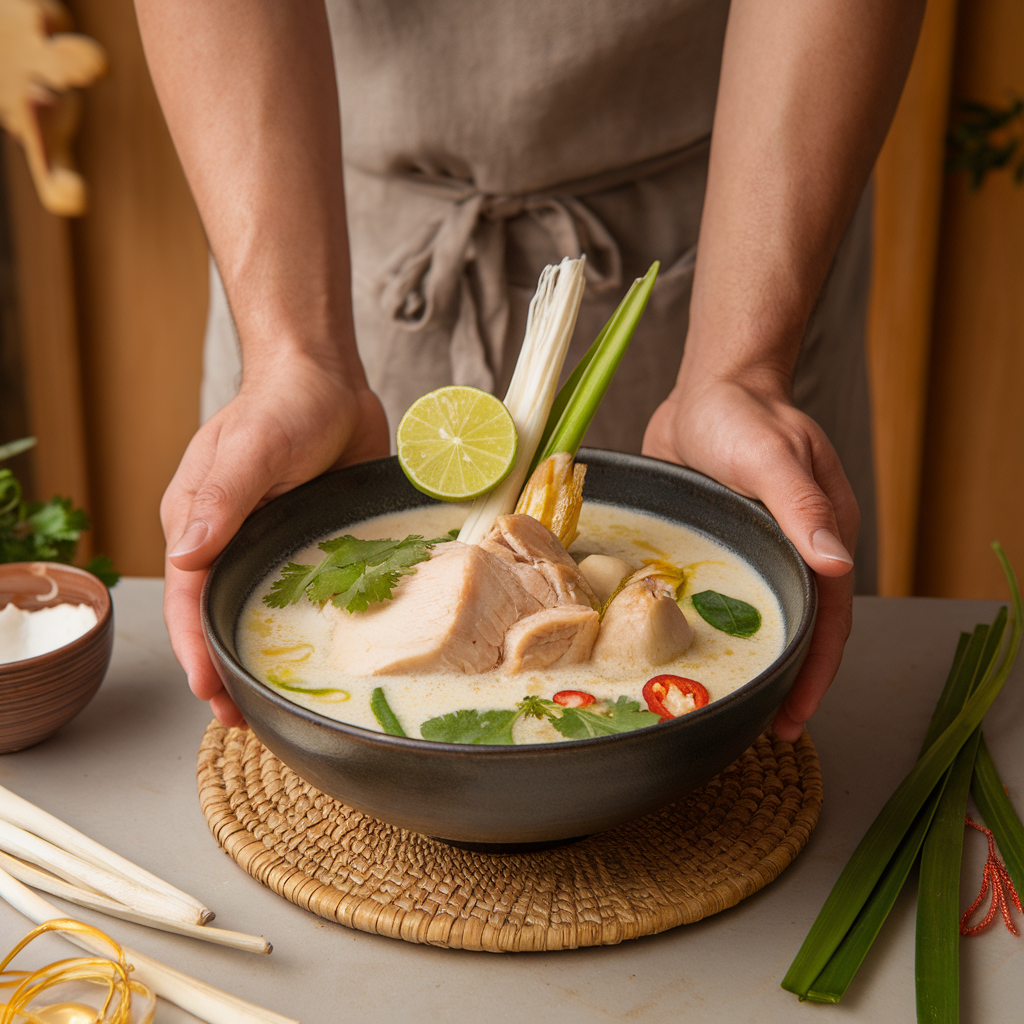If you’re a fan of exotic flavors, aromatic herbs, and comforting yet vibrant soups, then Tom Kha Gai is a must-try recipe. This classic Thai chicken soup is famous for its delicate balance of creamy coconut milk, spicy chilies, tangy lime, and fragrant herbs. Known as a signature dish of Thailand, it embodies the heart of Thai soup culture with its bold yet harmonious flavors.
Whether you’re searching for an authentic coconut soup, want to explore coconut chicken dishes, or simply crave a rich, flavorful chicken soup recipe with a tropical twist, this guide will equip you with everything you need. We’ll dive deep into its history, ingredients, preparation techniques, variations including how to use Portobello mushrooms, nutritional benefits, and even how it compares to other popular soups like minestrone. This detailed article is perfect for home cooks, food lovers, and culinary adventurers alike!
What is Tom Kha Gai?
Tom Kha Gai (ต้มข่าไก่) translates roughly as “chicken galangal soup.” It is a classic Thai chicken soup made with a fragrant broth infused with fresh galangal (a root similar to ginger but with citrus notes), lemongrass, kaffir lime leaves, and chilies. The broth is enriched with creamy coconut milk, giving it a velvety texture and mellow sweetness.
Unlike heavier, cream-based soups in Western cuisine, Tom Kha Gai maintains a refreshing balance by layering spicy, sour, salty, and sweet elements. This makes it both comforting and invigorating—a signature quality of authentic Thai curry and soup dishes.
Historical and Cultural Context of Tom Kha Gai
The origins of Tom Kha Gai trace back centuries in Thailand, where soups with herbal infusions and coconut milk have long been staples. The dish reflects the Thai philosophy of balancing tastes to achieve harmony in food. Traditionally, Tom Kha Gai was enjoyed as a home-cooked meal, often served as part of a multi-course Thai feast.
Its popularity has since exploded worldwide, making it a staple on Thai restaurant menus across the globe. It represents the perfect introduction to Thai cuisine for those new to the bold flavors of Southeast Asia, and a nostalgic comfort for those who grew up enjoying authentic Thai food.

Essential Ingredients and Their Roles
To create a truly authentic Thai chicken coconut soup, understanding the role of each ingredient is crucial:
- Chicken (breast or thigh): Provides the protein base. Thighs are juicier and more flavorful, while breasts offer leaner meat.
- Galangal: The signature flavor of Tom Kha. It adds a sharp, peppery, and citrus aroma different from ginger.
- Lemongrass: Adds fresh lemony notes and a slight woodiness.
- Kaffir lime leaves: Impart an intense citrus fragrance and flavor that is uniquely Thai.
- Coconut milk: The creamy foundation, mellowing the spices and adding richness.
- Bird’s eye chilies: Provide heat; quantity adjusted to your spice tolerance.
- Fish sauce: A salty, umami seasoning essential in Thai cooking.
- Lime juice: Gives the soup its distinctive sour punch.
- Mushrooms: Traditionally straw mushrooms, but button, oyster, or Portobello mushrooms are excellent alternatives.
- Sugar (palm sugar preferred): Balances the sourness and saltiness with subtle sweetness.
- Fresh cilantro: Adds fresh herbal brightness as garnish.
Step-by-Step Tom Kha Gai Recipe
Step 1: Infuse the Broth
Begin by bringing 4 cups of chicken broth to a boil. Add sliced galangal, smashed lemongrass stalks, and torn kaffir lime leaves. Let this simmer gently for 10-15 minutes to infuse the broth with fragrant herbal notes essential to the soup’s flavor.
Step 2: Cook the Chicken and Mushrooms
Add thinly sliced chicken and your choice of mushrooms. Allow the soup to simmer for about 7 minutes or until the chicken is cooked through and mushrooms are tender.
Step 3: Stir in the Coconut Milk
Lower the heat and gently stir in the coconut milk. Simmer gently for another 5-7 minutes. Avoid boiling vigorously to prevent curdling and to keep the coconut milk creamy.
Step 4: Season with Fish Sauce, Chilies, and Sugar
Add fish sauce for saltiness, bird’s eye chilies for heat, and palm sugar to balance the flavors. Taste frequently and adjust seasoning to your preference.
Step 5: Add Lime Juice for Sourness
Remove from heat and add freshly squeezed lime juice. This bright, tangy component is what truly defines Tom Kha Gai.
Step 6: Garnish and Serve
Serve hot, garnished with fresh cilantro leaves. Enjoy on its own or with steamed jasmine rice.

Expert Tips for a Perfect Thai Chicken Soup
- Use fresh ingredients wherever possible, especially herbs.
- Slice chicken thinly to ensure even, quick cooking.
- Don’t over-boil once coconut milk is added to maintain creaminess.
- Adjust spice levels to your liking by adding or reducing chilies.
- For deeper flavor, use homemade chicken broth.
- Consider pounding the lemongrass stalks before adding to release more aroma.
Using Portobello Mushrooms: A Unique and Delicious Variation
While straw mushrooms are traditional, Portobello mushrooms add a robust, meaty texture and earthy flavor that can deepen the soup’s complexity. Their large caps absorb the coconut broth beautifully, making the soup more filling. Slice them thinly and add along with or instead of other mushrooms.
How Tom Kha Gai Fits Into Broader Culinary Categories
- Thai Chicken Soup: Tom Kha Gai is a prime example of Thailand’s aromatic, herb-forward chicken soups.
- Thai Soup: Alongside dishes like Tom Yum, Tom Kha offers a creamy, coconut-based contrast.
- Coconut Soup: The use of coconut milk places it in the global family of coconut soups popular in tropical cuisines.
- Thai Curry: While not a curry in the traditional sense, the use of coconut milk and herbs is reminiscent of Thai curry bases.
- Chicken Soup Recipes: It stands apart from Western chicken soups by its bold herbal profile and creamy texture.
- Minestrone Comparison: Compared to Italian minestrone—vegetable-heavy and tomato-based—Tom Kha is lighter, focused on herbs and coconut, but equally comforting.
Nutritional Profile and Health Benefits
Tom Kha Gai provides lean protein from chicken and healthy fats from coconut milk. The fresh herbs and spices contribute antioxidants and anti-inflammatory benefits. Its balance of flavors can stimulate digestion and provide comfort during illness or colder seasons.
Serving Suggestions and Pairings
For a complete meal, serve Tom Kha Gai with:
- Steamed jasmine rice or sticky rice to soak up the flavorful broth.
- Fresh spring rolls or Thai chicken satay for appetizers.
- Som Tum (green papaya salad) for a refreshing side.
- Thai iced tea or coconut water to balance the spice.
- Light stir-fried vegetables to round out the meal.
Variations to Customize Your Tom Kha Gai
- Vegetarian: Use tofu and vegetable broth, replace fish sauce with soy sauce or tamari.
- Seafood: Swap chicken for shrimp or fish.
- Extra Veggies: Add baby corn, cherry tomatoes, or snap peas.
- Spicy: Add Thai red curry paste to spice it up.
- Noodle Soup: Add cooked rice noodles for a heartier dish.
Common Questions About Tom Kha Gai
- Can I use ginger instead of galangal? Yes, but galangal has a sharper, citrusy flavor.
- Is Tom Kha Gai gluten-free? Yes, if you use gluten-free fish sauce and broth.
- Can I make this soup ahead? Yes, but add lime juice fresh before serving.
- How spicy is it? Traditionally moderately spicy; adjust chilies to taste.

Cooking Equipment Needed
- Medium saucepan or pot
- Knife and cutting board
- Measuring spoons and cups
- Ladle and serving bowls
Full Printable Shopping List
- Chicken breast or thighs – 1 lb (450 g)
- Chicken broth – 4 cups (1 liter)
- Coconut milk (full fat) – 1 can (14 oz/400 ml)
- Fresh galangal – 3-4 slices
- Lemongrass stalks – 3, smashed and cut
- Kaffir lime leaves – 5-6 leaves
- Bird’s eye chilies – 3-4, whole or sliced
- Mushrooms (Portobello, straw, button) – 200 g
- Fish sauce – 2-3 tbsp
- Lime juice – 1-2 tbsp
- Palm sugar or regular sugar – 1 tsp
- Fresh cilantro – small bunch
Final Thoughts: Experience the Magic of Tom Kha Gai
Tom Kha Gai is not just a soup; it’s an experience—combining aromatic herbs, creamy coconut, spicy heat, and bright sourness in one harmonious bowl. Perfect for those who love authentic Thai chicken soup, crave rich coconut chicken flavors, or want to explore Thai curry-inspired broths.
By mastering this recipe, you open the door to countless variations and deeper understanding of Thai culinary traditions. With simple ingredients and straightforward steps, you can enjoy a restaurant-quality Thai soup at home anytime.
Ready to Cook?
Gather your ingredients, follow this comprehensive guide, and enjoy a bowl of comforting, flavorful Tom Kha Gai that warms your body and delights your senses. Don’t forget to share your creation with family and friends — this is one soup that brings people together.

